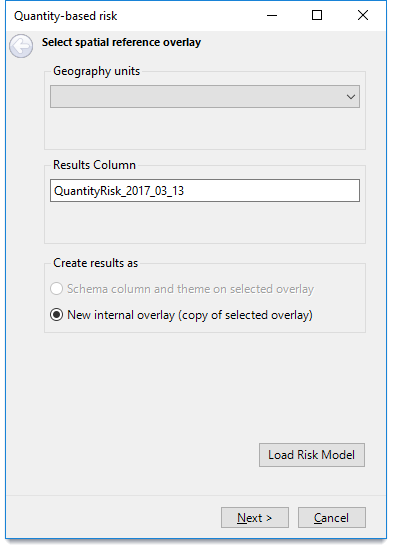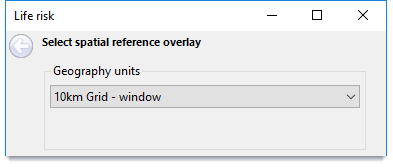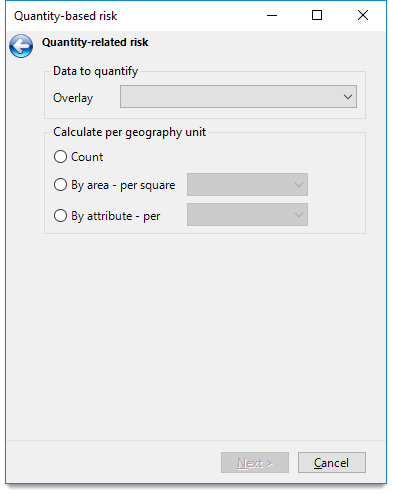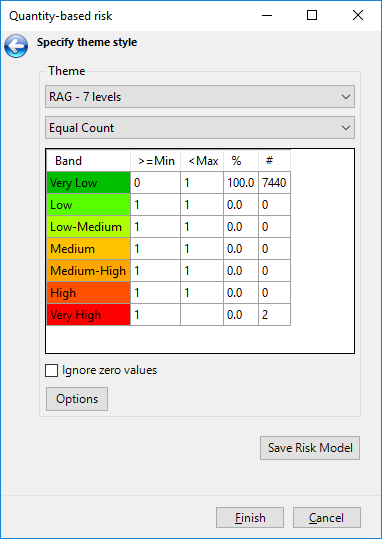Quantity
Creates a count-based map based on the number of items within geography units.
Click Applications > Risk and select Quantity. 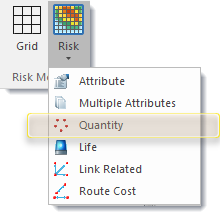
This opens the quantity-based risk wizard.
1. Geography units
Select the overlay that will receive the thematic result of the risk calculation. This could be the grid overlay created in the Grid command.
For example:
2. Results Column
This entry specifies the Results Column.
The risk calculation will result in the items in the spatial reference overlay receiving an attribute with their individual risk value.
A default name will be suggested for this attribute – based on the type of risk calculation and the date the command is run.
For example:

You can edit this to any name providing it conforms with the rules of SIS Desktop property names, i.e. alphanumeric and underscore characters only.
The Results Column property is of type double, e.g. QuantityRisk_2017_03_13#.
TIP: The # need not be entered into the Results Column box.
This property is added to the overlay’s schema.
If the schema already includes a property of this name, you will be warned of existing values that may be overwritten:

3. Create results as

Schema column and theme on selected overlay: The Geography units entry at the top of the dialog specifies the overlay on which the resultant risk map is to be based (e.g. super output areas.)
If the selected spatial reference overlay is not editable, only the New internal overlay (copy of selected overlay) option is made available.
4. Load Risk Model
Click Load Risk Model to load a previously saved risk model.
Click Next to select your overlays.
1. Data to quantify
Select the overlay containing the data contributing to the risk from the Overlay drop-down.
Note: All overlays are listed (e.g. the analysis can be performed on an invisible overlay.)
2. Calculate per geography unit
Select the calculation output:
- Count: the number of ‘risk items’ in each geography unit.
- By area - per square: the count in a geography unit divided by the area of the geography unit in either square mile or square Km
- By attribute - per: the count in a geography unit divided by the specified attribute on the geography unit. Only numeric attributes are listed in the drop-down.
On completion of the Quantity-related risk dialog click Next.
The final window is the Specify theme style window:
Use the drop-down menu to set the theme style.
There are two sets of Themes:
- RAG: Red Amber Green risk colours
- Heat – based on green to red hotspot colours.
TIP: Themes are defined in the Risk Modeller's configuration file: riskModellerConfig.xml.
Use the second drop-down to define how the bands are calculated for the current set of results (i.e. by Equal Range, Percentiles or Equal Count.)
A note on Percentiles:
Percentile band values can be changed by editing the values in the >=
The theme Band ranges can be manually adjusted by entering new values in the >=Min column. These are then used as the defaults for future uses of the theme.
The decision to use any of these options depends on the actual values.
The theme Band ranges can be manually adjusted by entering new values in the >=Min column.
Check the Ignore zero values tickbox if required.
Click Options to display the Theme Settings dialog:.png)
| Option | Description | |
|
Theme pen for geography units |
If required change the pen style by selecting a style from the Style drop-down box. |
|
|
When ignoring zero values |
Check the Set zero values blank in theme tickbox to prevent all zero values which could result in large areas of colour being shown in the output grid. |
|
|
Theme Labels |
Check the Label ranges with numeric limits tickbox to label the ranges with numeric values. |
|
Click OK and the Save Risk Model button to save the Risk Model.The model settings are saved as a .JSON file.
Click Finish on the Specify theme style dialog.
